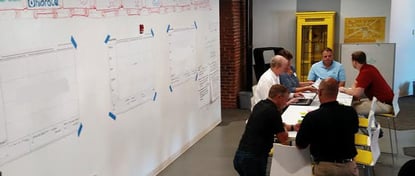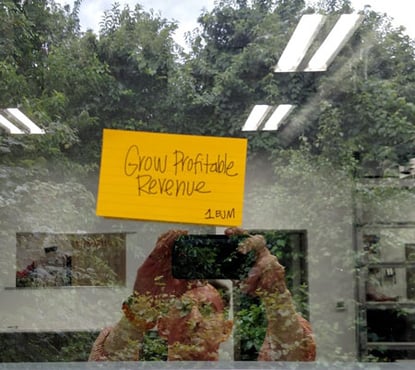What if your team needs to foster strategic thinking? What can you do to quickly go from random comments to actual strategic thinking?
Number 1? Understand that strategic thinking is not the same thing as strategy. This is a central point when looking at strategic thinking roles, responsibilities, and expected capabilities. While the leadership team sets strategy, everyone in an organization needs to engage in strategic thinking.
As we define it, strategic thinking means addressing what matters with insights and innovation. Everyone needs support in:
- Understanding what matters
- Forming thoughtful perspectives on what they are learning about how the organization can operate better (otherwise known as insights)
- Seeking new ways to improve current performance (or, if you like, innovation)
If everyone is able to address these three strategic thinking fundamentals, your organization will improve, even if it’s already great.
Improving Strategic Thinking

Using the three-part definition, you can look at a team member’s performance in each of the areas to gauge where they’re starting from and how quickly they are able to improve strategic thinking.
Let’s review the three areas and identify ways to quickly assess strategic thinking skills.
Part 1. Understanding What Matters
We see non-strategic thinkers getting bogged down too early in addressing what to do and how to do it. These people are easily swept away in activities that may or not contribute to anything important. Thus, our favorite recommendation for improving strategic thinking skills is to master the use of a simple question: What are we trying to achieve?
Achievement goals will differ in specificity based on where the question is asked and what level of the organization is asking. For strategically sound organizations, though, there should be a common thread everywhere in answers to the question. Routinely asking this question grounds any conversation, request, directive, and even new idea in things that should help the organization achieve its most important goals. That sets the stage for strategic thinking.
Coach your team members to make sure that they are always seeking to understand what matters. If they are removed from directly impacting the things that matter most (revenue, profitability, addressing the organization’s mission, satisfying customers, etc.), make sure they are reaching out to people with direct responsibilities in these areas. Broad perspectives on what matters are vital to a solid understanding of what’s important for the organization.
Part 2. Forming Insights
The second part of the definition involves insights. Let’s think of insights as information + implications. This formula allows you to gauge how a team member is doing as well as address improvement opportunities.
When a team member shares what they presume to be an insight, is it grounded in information? It may be quantitative data; it could also include information based on experience, observations, logic, strategic realities, or other inputs. At its heart, an insight has to be more than speculation, hearsay, or unfounded conjecture. (Are you listening, Washington, DC?)
And implications? Does a team member share information that suggests meaning or action, even if the action is to wait, do nothing, or continue to monitor a situation? Information coupled with implications related to things that matter, signals a team member is delivering strategic insights. Without implications, someone who shares information is simply a reporter.
Part 3. Innovative Ideas
Innovation is a fundamental improvement in the status quo. It may not be a sexy definition, but it opens the door so that anyone in your organization can generate innovative ideas.
The assessment here is comparable to the others; when a team member suggests improvements, are they fundamental or otherwise related to what matters, and do they provide a marked change in current activities and situations? If a concept is on the periphery between “what you do” and “no one will ever notice the change,” then it isn’t innovation.
Innovative ideas will trigger affirmative answers to more than one of the following questions:
- If we don’t pursue this idea, will its absence be widely perceived?
- If we do pursue it, will its impact be widely noticed?
- Will ignoring the underlying situation or opportunity create significant issues?
Putting It Back Together
It’s clear: we like to break big concepts into simple definitions and formulas to make them actionable. In this case, you can aggregate and disaggregate this view to both gauge where you and your team are performing and highlight ways to improve each team member's strategic thinking. – Mike Brown




